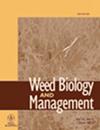芝麻生产中杂草防治的关键时期
IF 1.5
4区 农林科学
Q3 AGRONOMY
引用次数: 9
摘要
在种植系统中规划有效的杂草控制需要准确评估杂草的强度和它们与作物竞争的持续时间。为了确定芝麻田杂草的关键防治期,进行了为期2年的研究。使用四参数对数逻辑模型监测和分析相关和相对作物产量。我们记录了无杂草地块的数据,并将其与杂草干扰不同时期的数据进行了比较。在两个研究年份中,杂草干扰时间越长,芝麻的相对产量越低,而随着无杂草期的延长,产量越高。如果允许杂草从播种到收获与作物竞争,芝麻产量下降了51-78.7%。第一年杂草防治关键期(CPWC)为177 ~ 820生长度日(GDD),对应于作物出苗后14 ~ 64天,第二年为170 ~ 837生长度日(13 ~ 64天);这是基于5%的可接受产量损失。本研究的结果清楚地说明,从芝麻植株出苗后的第二周开始,必须保持无杂草的条件,至少保持到第9周,以避免芝麻产量损失超过5%。这些发现表明,种植者可以从CPWC中受益,以改善芝麻生产中的杂草控制,包括杂草控制计划的效果和成本。本文章由计算机程序翻译,如有差异,请以英文原文为准。
Critical period for weed control in sesame production
Planning effective weed control in cropping systems requires exact appraisal of the weed intensity and duration of their competition with the crops. This 2‐year study was carried out in order to determine the critical weed control period in sesame fields. Related and relative crop yields were monitored and analyzed using a four‐parametric log‐logistic model. We recorded data from weed‐free plots and compared these with data from different periods of weed interference. In both the study years, the longer period of weed interference decreased the relative yield of sesame, whereas the yield was increased with increasing duration of the weed‐free period. A 51–78.7% decline in sesame yield was noted if the weeds were allowed to compete with the crop from planting to harvest. In the first year, the duration of the critical period for weed control (CPWC) was 177–820 growing degree days (GDD), which corresponded to 14–64 days after crop emergence (DAE), and between 170 and 837 GDD (13–64 DAE) in the second year; this was based on a 5% acceptable yield loss. The results of this study clearly elaborated that maintaining weed‐free conditions is compulsory from as early as the second week after the emergence of sesame plants, and this should be maintained at least until the ninth week to avoid sesame yield losses by more than 5%. These findings show that growers can benefit from CPWC to improve weed control in sesame production, including the efficacy of a weed control program and its cost.
求助全文
通过发布文献求助,成功后即可免费获取论文全文。
去求助
来源期刊

Weed Biology and Management
农林科学-农艺学
CiteScore
2.70
自引率
0.00%
发文量
13
审稿时长
>36 weeks
期刊介绍:
Weed Biology and Management is an international journal, published four times per year. The journal accepts contributions in the form of original research and review articles in all aspects of weed science. Contributions from weed scientists in the Asia–Pacific region are particularly welcomed.
The content of the contributions may relate to weed taxonomy, ecology and physiology, weed management and control methodologies, herbicide behaviors in plants, soils and environment, utilization of weeds and other aspects of weed science. All contributions must be of sufficient quality to extend our knowledge in weed science.
 求助内容:
求助内容: 应助结果提醒方式:
应助结果提醒方式:


